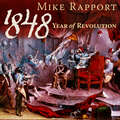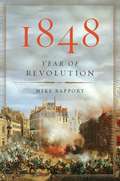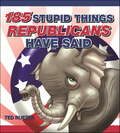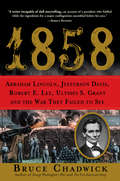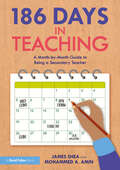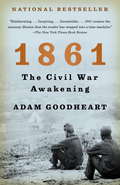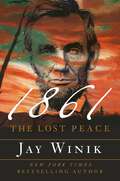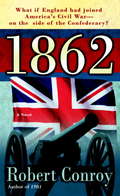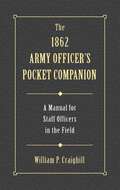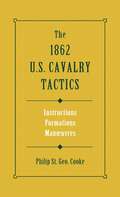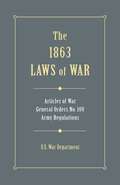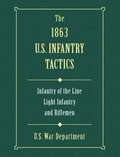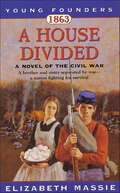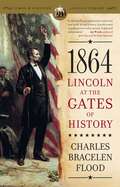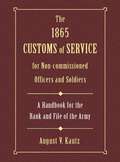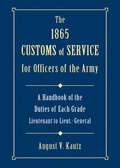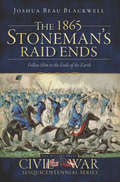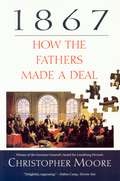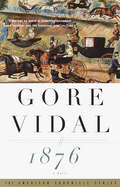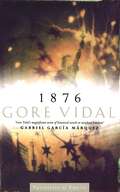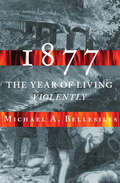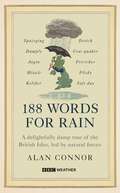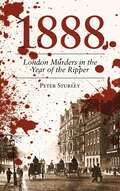- Table View
- List View
1848: Year Of Revolution
by x Mike RapportIn 1848, Europe was engulfed in a firestorm of revolution. The streets of cities from Paris to Bucharest and from Berlin to Palermo were barricaded and flooded by armed insurgents proclaiming political liberties and national freedom. The conservative order which had held sway since the fall of Napoleon in 1815 crumbled beneath the revolutionary assault. This book narrates the breathtaking events which overtook Europe in 1848, tracing brilliantly their course from the exhilaration of the liberal triumph, through the fear of social chaos to the final despair of defeat and disillusionment. The failures of 1848 would scar European history with the contradictions of authoritarianism and revolution until deep into the twentieth century.
1848: Year of Revolution
by Mike RapportIn 1848, a violent storm of revolutions ripped through Europe. The torrent all but swept away the conservative order that had kept peace on the continent since Napoleon's defeat at Waterloo in 1815--but which in many countries had also suppressed dreams of national freedom. Political events so dramatic had not been seen in Europe since the French Revolution, and they would not be witnessed again until 1989, with the revolutions in Eastern and Central Europe. In1848, historian Mike Rapport examines the roots of the ferment and then, with breathtaking pace, chronicles the explosive spread of violence across Europe. A vivid narrative of a complex chain of interconnected revolutions,1848tells the exhilarating story of Europe's violent "Spring of Nations" and traces its reverberations to the present day.
185 Stupid Things Republicans Have Said
by Ted RueterTed Rueter panders to Republican party lines by collecting 370 oratorical guffaws credited to popular politicians. Categorized in alphabetical order and presented by subject topic, the quips include:Osama bin Laden: "[Osama bin Laden] is either alive and well or alive and not well or not alive." —Donald RumsfeldMisunderestimation: "They misunderestimated me." —George W. Bush
1858: Abraham Lincoln, Jefferson Davis, Robert E. Lee, Ulysses S. Grant and the War They Failed to See
by Bruce Chadwick1858 explores the events and personalities of the year that would send the America's North and South on a collision course culminating in the slaughter of 630,000 of the nation's young men, a greater number than died in any other American conflict. The record of that year is told in seven separate stories, each participant, though unaware, is linked to the oncoming tragedy by the central, though ineffective, figure of that time, the man in the White House, President James Buchanan. The seven figures who suddenly leap onto history's stage and shape the great moments to come are: Jefferson Davis, who lived a life out of a Romantic novel, and who almost died from herpes simplex of the eye; the disgruntled Col. Robert E. Lee, who had to decide whether he would stay in the military or return to Virginia to run his family's plantation; William Tecumseh Sherman, one of the great Union generals, who had been reduced to running a roadside food stand in Kansas; the uprising of eight abolitionists in Oberlin, Ohio, who freed a slave apprehended by slave catchers, and set off a fiery debate across America; a dramatic speech by New York Senator William Seward in Rochester, which foreshadowed the civil war and which seemed to solidify his hold on the 1860 Republican Presidential nomination; John Brown's raid on a plantation in Missouri, where he freed several slaves, and marched them eleven hundred miles to Canada, to be followed a year later by his catastrophic attack on Harper's Ferry; and finally, Illinois Senator Steven Douglas' seven historic debates with little-known Abraham Lincoln in the Illinois Senate race, that would help bring the ambitious and determined Lincoln to the Presidency of the United States. As these stories unfold, the reader learns how the country reluctantly stumbled towards that moment in April 1861 when the Southern army opened fire on Fort Sumter.
186 Days in Teaching: A Month-by-Month Guide to Being a Secondary Teacher
by James Shea Mohammed A. Amin186 Days in Teaching provides a month-by-month roadmap for the school year, helping secondary teachers quickly adapt to new environments, accomplish the many tasks expected of them and excel in roles that might be unfamiliar or outside their initial training.The book covers all aspects of teaching and learning as well non-teaching responsibilities, ensuring you know exactly what is coming up and how to prepare for it successfully. By offering practical advice, research-based strategies and evidence-informed approaches, this guide helps teachers navigate the annual cycle of school life while building the necessary skills and knowledge to remain adaptable and accelerate their careers. Key topics include retaining autonomy, curriculum design, pastoral care and effective communication. Drawing on well-known theories of community practice, it empowers teachers to become active agents in shaping their school’s ethos and teaching practices.With a focus throughout on your well-being and job satisfaction, this is essential reading for all secondary teachers, especially those new to the profession, aiming to build a fulfilling, sustainable career in a diverse education landscape.
1861
by Adam GoodheartAs the United States marks the 150th anniversary of our defining national drama, 1861 presents a gripping and original account of how the Civil War began.1861 is an epic of courage and heroism beyond the battlefields. Early in that fateful year, a second American revolution unfolded, inspiring a new generation to reject their parents' faith in compromise and appeasement, to do the unthinkable in the name of an ideal. It set Abraham Lincoln on the path to greatness and millions of slaves on the road to freedom.The book introduces us to a heretofore little-known cast of Civil War heroes--among them an acrobatic militia colonel, an explorer's wife, an idealistic band of German immigrants, a regiment of New York City firemen, a community of Virginia slaves, and a young college professor who would one day become president. Adam Goodheart takes us from the corridors of the White House to the slums of Manhattan, from the mouth of the Chesapeake to the deserts of Nevada, from Boston Common to Alcatraz Island, vividly evoking the Union at this moment of ultimate crisis and decision.From the Hardcover edition.
1861: The Lost Peace
by Jay WinikFrom an award-winning historian and New York Times bestselling author, a gripping, fly-on-the-wall account of the weeks leading up to Abraham Lincoln's decision to go to war against the Confederacy.1861: The Lost Peace is the story of President Lincoln&’s difficult and courageous decision at a time when the country wrestled with deep moral questions of epic proportions. Through Jay Winik&’s singular reporting and storytelling, readers will learn about the extraordinary Washington Peace Conference at the Willard Hotel to avert cataclysmic war. They will observe the irascible and farsighted Senator JJ Crittenden, the tireless moderate seeking a middle way to peace. Lincoln himself called Crittenden &“a great man&” even as Lincoln jousted with him. Readers will glimpse inside Lincoln&’s cabinet—the finest in history—which rivaled the executive in its authority, a fact too often forgotten, and witness a parade of statesmen frenetically grasping for peace rather than the spectacle of a young nation slowly choking itself to death. A perfect read for history buffs, with timely overtones to our current political climate.
1862
by Robert ConroyThe Civil War comes alive in all its passion and fury, only now the Brits are fighting alongside the Confederacy. Outraged when the U.S. Navy seizes three Confederates aboard an English sailing ship, Britain retaliates by entering the fray in support of the Rebels and suddenly it's a whole new war. Once again, cotton is king as the North's blockade crumbles before the might of the Royal Navy. While Lincoln confronts the monumental challenge of vanquishing mighty Britannia, the Redcoats revive their 1812 penchant for burning down American cities, and Union troops see Canada as ripe for the picking. From the Mississippi bayou to the Pennsylvania farmlands to the woods of Maine, the great armies of Generals Grant and Lee face off in the nation's deadliest conflict. And to the victor goes history.
1862 Army Officer's Pocket Companion
by William P. CraighillUnique summary of "military science" as it stood at the beginning of the Civil War.
1862 Fredericksburg: A New Look at a Bitter Civil War Battle (Panorama)
by K. M. KostyalNIMAC-sourced textbook
1862 US Cavalry Tactics
by Philip St. CookeDirected by the U.S. War Department in 1859 to prepare a new, revised manual for U.S. cavalry operations, then-Col. Philip St. George Cooke produced this book after extensive research of cavalry tactics used by the advanced nations in Europe, where he had been an observer in the Crimean War (1854-1856). Originally published in 1860, the book was revised in 1861 and 1862. This 1862 Government Printing Office edition combines the former two volume work into one book.
1863 Laws of War
by U.S. War Department• The "rules of warfare" and "government of the army" as they existed in the American Civil War• All 101 Articles of War as amended through June 1863 including the famous Lieber Code (General Orders No. 100), directed by President Lincoln, which expanded the laws of land warfare and General Orders No. 49 on the granting of paroles• Copious extracts from the Revised U.S. Army Regulations through June 1863This compendium of laws and rules is a testimony to America's reverence for the rule of law as well as its high regard for "civilized" behavior on the battlefield. The Articles of War were normative rules covering military duty and punishments allowed for violations. The Lieber Code was a new and profound law for the conduct of armies in the field, to include humane treatment of prisoners and protection of property and civilians. It had a profound affect on the evolution of the laws of land warfare in use today. Army Regulations, on the other hand, dealt with the administration and management of the army-from personnel assignments to supply and recruiting operations-all three sets of rules were used by both the Union and Confederate armies.An essential reference for students, historians, writers, reenactors, and those interested in how our Civil War armies operated.
1863 US Infantry Tactics
by U.S. War Department• The authorized book for the instruction, exercise, and maneuver of U.S. Infantry during the Civil War• Includes articles of war, an extensive dictionary of Civil War military terms, and sheet music for military bugle calls• A must-have book for historians, researchers, reenactors, and writersWritten in 1861 at the direction of the War Department and copiously illustrated, this was the book used to train, lead, and maneuver U.S. Infantry units on Civil War battlefields. It contains the school of the soldier, the company, and battalion or fielded regiment, along with all-important instructions for skirmishers. Over 15 pages of field music, the articles of war in use at the time, and a dictionary of Civil War military terminology completes this extensive work.
1863: A Novel of the Civil War (Young Founders)
by Elizabeth MassieAmerica as seen through the eyes of its young founders.By April 1863 the Civil War has been raging for two years. On their sleepy farm in Gettysburg, sixteen-year-old twins Susanne and Stephen are alarmed by news that Confederate forces under General Robert E. Lee are threatening to invade the North for a strike at Washington, D.C.! Rebel forces in the Union capital? Is it possible?Bored with farm life and itching for action, Stephen runs away to join the beleaguered Army of the Potomac to fight Johnny Reb. Susanne decides to join a nursing outfit to assist the Union's wounded. Sparated by war, death, and disease, the twins maintain a correspondence. But little do they know that Union and Confederate forces are converging on a small town for a battle that may determine the outcome of the war--a town called Gettysburg.At the Publisher's request, this title is being sold without Digital Rights Management Software (DRM) applied.
1864
by Charles Bracelen FloodIn a masterful narrative, historian and biographer Charles Bracelen Flood brings to life the drama of Lincoln's final year, in which he oversaw the last campaigns of the Civil War, was reelected as president, and laid out his majestic vision for the nation's future in a reunified South and in the expanding West.
1864 ... Fear About Capital: A series of murders always carries with it a series of investigations ...
by Anna Maria Stratta and Franca Bosco1864 ... Fear About Capital by Anna Maria Stratta and Franca Bosco A series of murders always carries with it a series of investigations ... 1864 ... fear of the capital In an apartment in Piazza Vittorio, a young aristocrat had just taken the life of his mistress. As the nobleman walked away, conflicting emotions within him tormented him but at the same time exalted him. How nice to be masters of the life of another human being. Deciding to end the existence of another person made him feel almost omnipotent. These were the thoughts that crowded his head as an evil grin pursed his lips.
1865 Customs of Service for Non-Commissioned Officers & Soldiers
by August KautzReproduction edition of the Civil War era guidebook. Indispensable for historians and reenactors.
1865 Customs of Service for Officers in the Army
by August KautzThe 1865 Customs of Service for Officers in the Army
1865 Stoneman's Raid Ends, The: Follow Him to the Ends of the Earth (Civil War Ser.)
by Joshua Beau BlackwellIn the spring of 1865, George Stoneman's cavalry division departed Salisbury, North Carolina, with one objective in mind: returning home. However, after the collapse of the Confederacy, the mounted division was ordered to apprehend the exiled Confederate president Jefferson Davis, even if it meant "follow[ing] him to the ends of the earth."? By May, the raid had transformed into an uphill struggle of frustration, pillage, revenge, terror and wavering loyalty to the flag as the troopers crashed down on the civilian populations that lay in their path with demonical ferocity. Taking into account local folklore and traditions of the raid, historian Beau Blackwell follows the column's course as it sacks the city of Asheville, canvasses the Palmetto State, plunders Greenville, terrorizes Anderson and ultimately tramples the soil of Georgia.
1867: How the Fathers Made a Deal
by Christopher Moore“In the 1860s, western alienation began at Yonge Street, and George Brown was the Preston Manning of the day. ” So begins Christopher Moore’s fascinating 1990s look at the messy, dramatic, crisis-ridden process that brought Canada into being – and at the politicians, no more lovable or united than our own, who, against all odds, managed to forge a deal that worked. From the first chapter, he turns a fresh, perceptive, and lucid eye on the people, the issues, and the political theories of Confederation – from John A. Macdonald’s canny handling of leadership to the invention of federalism and the Senate, from the Quebec question to the influence of political philosophers Edmund Burke and Walter Bagehot. This is a book for all Canadians who love their country – and fear for it after the failure of the constitution-making of the 1990s. Here is a clear, entertaining reintroduction to the ideas and processes that forged the nation. From the Hardcover edition.
1876 (Vintage International)
by Gore VidalThe third volume of Gore Vidal's magnificent series of historical novels aimed at demythologizing the American past, 1876 chronicles the political scandals and dark intrigues that rocked the United States in its centennial year.------Charles Schermerhorn Schuyler, Aaron Burr's unacknowledged son, returns to a flamboyant America after his long, self-imposed European exile. The narrator of Burr has come home to recoup a lost fortune by arranging a suitable marriage for his beautiful daughter, the widowed Princess d'Agrigente, and by ingratiating himself with Samuel Tilden, the favored presidential candidate in the centennial year. With these ambitions and with their own abundant charms, Schuyler and his daughter soon find themselves at the centers of American social and political power at a time when the fading ideals of the young republic were being replaced by the excitement of empire.------"A glorious piece of writing," said Jimmy Breslin in Harper's. "Vidal can take history and make it powerful and astonishing." Time concurred: "Vidal has no peers at breathing movement and laughter into the historical past."------With a new Introduction by the author.
1876: Number 3 in series (Narratives of empire)
by Gore VidalWith the centennial year of the United States as the target of this historical novel, Gore Vidal again mounts a glorious expedition into that grimy and intricate activity called politics. And this is politics as it ought to be: gossip, corruption, money, dinner parties, more corruption, and all the tacky panoply of power. Into the rarefied atmosphere of a world where money has begun to talk very loudly ? usually through the mouths of people called Astor ? step Charles Schuyler and his daughter Emma. Charlie is the unacknowledged bastard son of Aaron Burr; Emma is rather beautiful; and both think it is prudent to return from penury in Europe and secure a fortuitous marriage for Emma. But America is no longer a young republic; it's a fledgling international superpower with its attendant seedy administration, dubious election campaigns, snobbery, 'popped corn', 'speaking tubes' and 'perpendicular railways' (lifts). It's a world that will welcome into its social and political bosom these two attractive exotics with the right names. And it's a world whose every political peccadillo, social slip-up and irresistible intrigue is recorded in this, the journal of Charlie Schuyler.
1877: America's Year of Living Violently
by Michael A. Bellesiles&“[A] powerful examination of a nation trying to make sense of the complex changes and challenges of the post–Civil War era.&” —Carol Berkin, author of A Brilliant Solution: Inventing the American Constitution In 1877—a decade after the Civil War—not only was the United States gripped by a deep depression, but the country was also in the throes of nearly unimaginable violence and upheaval, marking the end of the brief period known as Reconstruction and reestablishing white rule across the South. In the wake of the contested presidential election of 1876, white supremacist mobs swept across the South, killing and driving out the last of the Reconstruction state governments. A strike involving millions of railroad workers turned violent as it spread from coast to coast, and for a moment seemed close to toppling the nation&’s economic structure. Celebrated historian Michael A. Bellesiles reveals that the fires of that fated year also fueled a hothouse of cultural and intellectual innovation. He relates the story of 1877 not just through dramatic events, but also through the lives of famous and little-known Americans alike. &“A superb and troubling book about the soul of Modern America.&” —William Deverell, director of the Huntington-USC Institute on California and the West &“A bold, insightful book, richly researched, and fast paced . . . Bellesiles vividly portrays on a single canvas the violent confrontations in 1877.&” —Alfred F. Young, coeditor of Revolutionary Founders: Rebels, Radicals, and Reformers in the Making of the Nation &“[A] wonderful read that is sure to appeal to those interested in the challenges of creating a post–Civil War society.&” —Choice
188 Words for Rain: A delightfully damp tour of the British Isles, led by natural forces (an official BBC Weather book)
by Alan Connor‘Alan knows everything, knows everyone, and writes beautifully too.’RICHARD OSMAN‘The man with the contents of the Oxford English Dictionary stored just above his left eyebrow … and he’s quite funny too.’RORY CELLAN-JONES'A gorgeous, funny tour of the British Isles as seen from the clouds.’KONNIE HUQFor fans of THE ETYMOLOGICON and VERY BRITISH PROBLEMS, a delightfully damp tour of the British Isles. Mizzle. Dreich. Raining knives and forks. A real mugga-fisty. A spot of plother...We Brits love talking about the weather. So much so that our islands have hundreds of words and phrases for rain, some self-explanatory and others that really leave us scratching our heads. From a light smirr in Aberdeen to a "it's raining knives and forks!" in the Brecon Beacons, each type of rain tells a story about the people and places it falls on.In this delightfully damp tour of the British Isles, writer and puddle-splasher Alan Connor digs deep into the meaning and quirky histories of over one hundred words for precipitation. He gets caught in a plash in Northumberland, crashes a fox's wedding in Devon and ponders the phenomenon of Brits-who-picnic-in-the-car, in this charming and witty celebration of our very British obsession.
1888: London Murders in the Year of the Ripper
by Peter StubleyIn 1888 Jack the Ripper made the headlines with a series of horrific murders that remain unsolved to this day. But most killers are not shadowy figures stalking the streets with a lust for blood. Many are ordinary citizens driven to the ultimate crime by circumstance, a fit of anger or a desire for revenge. Their crimes, overshadowed by the few, sensational cases, are ignored, forgotten or written off. This book examines all the known murders in London in 1888 to build a picture of society. Who were the victims? How did they live, and how did they die? Why did a husband batter his wife to death after she failed to get him a cup of tea? How many died under the wheels of a horse-driven cab? Just how dangerous was London in 1888?
